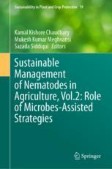Search
Search Results
-
Fungal Antagonists and their Effectiveness to Manage the Rice Root-knot Nematode, Meloidogyne graminicola
Meloidogyne graminicola, the rice root-knot nematode (RRKN), is becoming an increasing problem worldwide for rice farming, especially in intensive...
-
Effects of water salinization and substrata quality on the performance of the shredder Schizopelex festiva (Trichoptera; Sericostomatidae)
Secondary salinization is a growing concern for freshwaters worldwide. The lethal and sub-lethal effects on shredders are known, but not whether...

-
A Potential Source of Medicines from Fungi: An Overview of Biologically Active Secondary Metabolites
Fungi are the second largest group of living organisms that exist as distinct achlorophyllous, filamentous hyphae growing in diverse habitats...
-
Exploring the mycobiota of bromeliads phytotelmata in Brazilian Campos Rupestres
The phytotelmata is a water-filled tank on a terrestrial plant, and it plays an important role in bromeliad growth and ecosystem functioning. Even...

-
Joint effects of warming and salinization on instream leaf litter decomposition assessed through a microcosm experiment
Stream ecosystem functioning is often impaired by warming and salinization, but the joint effect of both environmental stressors on key processes...

-
Phytotherapy and combined nanoformulations as a promising disease management in aquaculture: a review
AbstractAquaculture-based foods have enriched nutritional and medicinal value to meet the needs of the global population. Recently, improper...

-
Wildfires alter stream ecosystem functioning through effects on leaf litter
BackgroundWildfires have strong impacts on terrestrial and aquatic ecosystems, whose frequency, severity, and intensity are increasing with climate...

-
Fungi in aquatic ecosystems
Fungi are phylogenetically and functionally diverse ubiquitous components of almost all ecosystems on Earth, including aquatic environments...

-
Salt Modulates Plant Litter Decomposition in Stream Ecosystems
Human activities are altering ion composition and concentrations in streams around the globe. This has implications for aquatic biota and for key...
-
Intra-specific leaf trait variability controls leaf decomposition of Vitis vinifera L. cultivars in streams
The decomposition of leaf litter is a key ecological process in stream ecosystems. Leaf traits, variable across species and within species,...

-
Decomposition of leaf litter mixtures in streams: effects of component litter species and current velocity
The effects of mixing different leaf litter species on litter decomposition in streams have received considerable attention in recent years. However,...

-
Terminal Restriction Fragment Length Polymorphism (T-RFLP) to Estimate Fungal Diversity
The identification of aquatic hyphomycetes associated with decomposing leaves in streams has been traditionally based on inducing sporulation, but...
-
Chemistry Matters: High Leaf Litter Consumption Does Not Represent a Direct Increase in Shredders’ Biomass
Changes in riparian vegetation can alter the input and quality of leaf litter in aquatic ecosystems, but the effects of these changes on litter...

-
Responses of Aquatic Hyphomycetes to Temperature and Nutrient Availability: a Cross-transplantation Experiment
Aquatic hyphomycetes represent a large component of the microbial assemblage that decomposes submerged leaf-litter in fluvial ecosystems. The...

-
Utilization of basal resources in a forested headwater stream: a combined stable isotope and fatty acid approach
In mountainous areas, forest headwater streams are characterized by a predominantly heterotrophic functioning resulting from massive seasonal...

-
Techniques for Handling Ingoldian Fungi
Ingoldian fungi or aquatic hyphomycetes are the dominant fungal group colonizing and decomposing leaf litter in streams. Mycelia of these fungi...
-
When Nutrients Become Contaminants in Aquatic Systems: Identifying Responses to Guide Terrestrial-Derived Detrital Endpoint Development for Managers
This chapter evaluates the case for inclusion of terrestrial-derived detrital endpoints, which are those metrics that describe changes to detrital...
-
Ecology and Diversity of Microaerophilic Fungi Including Endophytes
This chapter explores the extremophilic microaerophilic fungi along with endophytes. The relation between microaerophilic fungi and endophytes with...
-
The first fossil record of the anamorphic genus Zygosporium Mont. from the Oligocene of Csolnok (N Hungary)
Remains of a fungus with unique morphological characters were found on the leaf cuticle of a fossil leaf preserved in Oligocene deposits from...

-
Leaf consumption by invertebrate aquatic shredders in the Amazon: effects of climate change and microbial conditioning
We grew leaves of Montrichardia arborescens in four microcosm chambers with different temperatures and CO 2 concentrations simulating the scenarios of...

